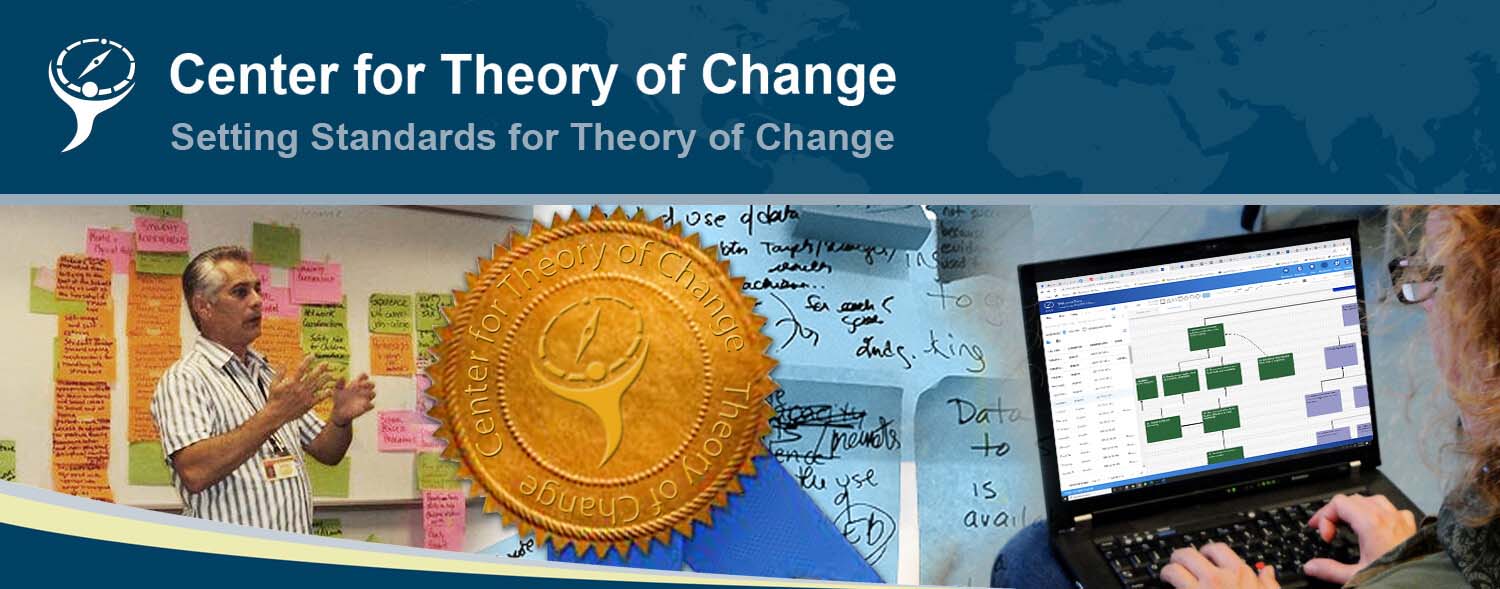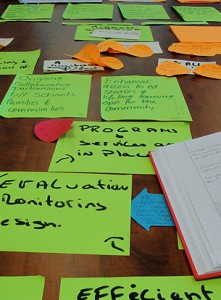| “Principios de teoría de cambio: Una introducción a la teoría de cambio” (Spanish) |
 Download PDF |
|
 |
“PACE Theory of Change: Discussion Paper” |  Download PDF |
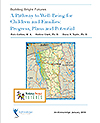 |
“Building Bright Futures: A Pathway to Well-Being for Children and Families: Progress, Plans and Potential” This report by ActKnowledge exemplifies the way in which a Collective Impact initiative can be conceptualized and practically implemented using a Theory of Change. |
 Download PDF |
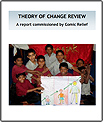 |
Theory of Change Review: A report commissioned by Comic Relief (2013). Written by Cathy James, this report provides a comprehensive review of the concept and application of Theory of Change in a development context. It makes significant reference to guidelines produced by ActKnowledge, including Theory of Change On-line. |
 Download PDF |
 |
Review of the use of ‘Theory of Change’ in international development, 2012. |  Download PDF |
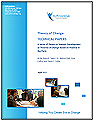 |
Theory of Change Technical Papers: A Series of Papers to Support Development of Theories of Change based on Practice in the Field, 2013.
These technical papers from ActKnowledge by Dr. Dana Taplin, Dr. Heléne Clark, Eoin Collins and David Colby cover core components of the concept of Theory of Change and key requirements for its effective implementation. The papers are based on the extensive experience of ActKnowledge in developing and implementing Theory of change in a variety of settings across the world. |
 Download PDF |
 |
Facilitators Source Book on the Theory of Change Process (2012)
By Dr. Dana Taplin and Muamer Rasic. |
 Download PDF |
 |
Theory of Change: The Basics, 2012.
By Dr. Dana Taplin and Dr. Heléne Clark. |
 Download PDF |
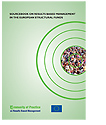 |
Sourcebook on results based management in the EU Structural Funds, 2013.
This comprehensive report on Results Based Management in the funds established to support EU regional policy draws on the insights of leading thinkers on results based management, including a significant contribution by Dr. Heléne Clark, Director of Act Knowledge on Theory of Change. |
 Download PDF |
 |
Understanding Theory of Change in International Development, 2012.
This is a review by Danielle Stein and Craig Valters of the concepts and debates within ‘Theory of Change’ (ToC) material, resulting from a search and detailed analysis of available donor, agency and expert guidance documents. The review was undertaken as part of a Justice and Security Research Program (JSRP) and The Asia Foundation (TAF) collaborative project, and focuses on the field of international development. |
 Download PDF |
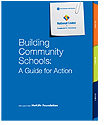 |
Building Community Schools: A Guide for Action (2011).
Prepared by the National Center for Community Schools, this is a comprehensive guide on building and sustaining community schools. It includes an appendix by Dr. Heléne Clark on Theory of Change basics for community schools. |
 Download PDF |
 |
Interrogating the Theory of Change: Evaluating Impact Investing Where it Matters Most 2013.
Written by Edward T. Jackson, this paper reviews cases where Theory of change has been used to good effect at various levels of the impact investing industry. |
 Download PDF |
 |
From Policies to Results: Developing capacities for country monitoring and evaluation systems.
This is No. 5 in a series: the Evaluation Working Papers (EWP), which present strategic evaluation findings, lessons learned and innovative approaches and methodologies from the Evaluation Office at UNICEF. |
 Download PDF |
 |
Where Are Young People in Youth Program Evaluation Research?
Written from the perspective of program evaluation, this journal article addresses young people’s participation in evaluations of programs meant to benefit them. The authors advocate deeper and broader participation of youth in program evaluation to benefit both youth and evaluation richness; and suggest changes in program and evaluation practice needed to incorporate youth participation. |
 Download PDF |
 |
Outcome Mapping: Building Learning and Reflection into Development Programs.
Book version. This group advocates an approach to theory of change that emphasizes changes in behavior, attitudes, and knowledge in people and organizations (boundary partners); rather than such end states as poverty alleviation and reduced conflict. Outcome Mapping focuses planning, monitoring, and evaluation on targeted behaviors, actions, and relationships within a program’s sphere of influence. A corresponding change in reporting requirements would be for donors to make their recipients accountable for demonstrating that they are progressing towards impact and improving in their effectiveness, but not accountable for the impact itself. This document explains the concepts of outcomes mapping and gives detailed instructions on facilitating participatory mapping sessions, devising monitoring and evaluation plans, and on evaluation design. |
 Download PDF |
 |
Learning from Change: Issues and experiences in participatory monitoring and evaluation
LEARNING FROM CHANGE – Chapter 1 |
 Download PDF |
 |
Results Based Monitoring & Evaluation Toolkit
Results Based Monitoring & Evaluation Toolkit. 2nd Edition, 2009. By Freer Spreckley |
 Download PDF |
 |
Scope: How Much Should a Good Theory Account For?
(130 kb, PDF file) A key question that comes up when undertaking a theory of change, is how much can, or should, the theory account for? Should it account for factors that are beyond the control of the program? Should it account for how each outcome is brought about? This article builds on the premise that how far the theory should go depends on the purpose of the theory and the availability of resources to pursue it. Therefore, one must know what they want the theory to explain and how they want to use it, to determine the appropriate scope. The scopes in increasing order detail: narrow and shallow, broad and shallow, narrow and deep, broad and deep. |
 Download PDF |
 |
Making Sense: Reviewing Program Design with Theory of Change
(96 kb, PDF file) This article considers the value and pitfalls of Theory of Change as a tool for evaluating program design. Because the Theory of Change approach carefully scrutinizes program design it can unearth both positives and negatives about a program to its stakeholders. |
 Download PDF |
 |
Tips and Challenges on Team Building with Theory of Change
(114 kb, PDF file) Many individuals are interested in Theory of Change as a tool for teambuilding. In this article, we explain why Theory of Change’s participatory process is a great complement but not a substitute or tool for teambuilding. |
 Download PDF |
 |
School Readiness Theory of Change
A detailed sample Theory of Change for school readiness in an imaginary Pennsylvania city. Outcomes Framework only. |
 Download PDF |
 |
The Media Justice Fund of the Funding Exchange: Looking at the Past, Thinking about the Future
The Media Justice Fund of the Funding Exchange: Looking at the Past, Thinking about the Future Final Evaluation Report Evaluation of the Funding Exchange’s Media Justice Fund (MJF), established with seed support from the Ford Foundation. Offering grants to thousands of social change grassroots organizations the Funding Exchange believed that a media justice fund would enable the development of media and communications systems that advance social justice. By prioritizing the engagement of social justice constituencies with media policy issues, MJF sought to build the infrastructure and capacity of fledgling media justice actors. |
 Download PDF |
 |
Process is Powerful: Planning and Evaluation for Media Activists
A practical guide to methods and tools that can help strengthen the movement to advance media justice planning and evaluation for media activists. |
 Download PDF |
 |
Monitoring & Evaluation Framework for the Rural Territorial Dynamics Program
Discussion of a monitoring and evaluation framework devised for a rural development program in several Latin American countries. The framework hews to the tenets of Outcomes Mapping, in which the theory of change focuses on how a program will affect its “boundary partners”, and to those of Developmental Evaluation, as advanced by M. Q. Patton. |
 Download PDF |
 |
The ‘Most Significant Change’ Technique: A guide to its use
Most significant change is a participatory monitoring and evaluation method that emphasizes telling stories and systematically reflecting on change; and which eschews indicators, particularly quantitative indicators. |
 Download PDF |
 |
The Challenge of Assessing Policy and Advocacy Activities: Strategies for a Prospective Evaluation Approach
White paper by the California Endowment on approaches to evaluation of policy and advocacy activities, where outcomes are far in the future. Among the recommendations are to focus on how activities are expected to produce long-term outcomes, on capacity change, on organizational learning as an overarching goal, and on contribution over attribution. |
 Download PDF |
 |
Developmental Evaluation
A brief summary prepared by this colleague of Michael Quinn Patton for the Methods Market May 2010 Conference, “Evaluation Revisited: improving the quality of evaluative practice by embracing complexity.” Unlike theories of change and logic models, the author argues that innovative social change efforts do not follow linear paths and need different evaluative approaches. “Social innovators operate in a disorderly and uncertain world characterized by complex, nonlinear dynamics.” Mainly, developmental evaluation relies upon trust between evaluator and evaluand. |
 Download PDF |
 |
Communities In Schools National Evaluation: Five Year Summary Report
Communities-in-Schools involves bringing community members and resources into schools to provide students with additional support. This evaluation used randomized controlled trials and found modest but consistent improvements on key indicators. |
 Download PDF |
 |
Public Reactions to New Street Tree Planting
The New York municipal government is in the midst of an aggressive tree planting program, including street trees. Residents can request trees; the city also plants trees along streets absent requests from property owners. Tree planting has increased written correspondence on the part of abuttors with the responsible municipal agencies. Public reactions to this large scale municipal planting are related to the dual public and private nature of the sidewalk, issues of territoriality, responsibility, aesthetics and place attachment. This study describes the results of content and spatial analysis of the correspondence. Qualitative analysis of the correspondence revealed public perceptions and concerns related to the MillionTreesNYC program. Spatial analysis explored the relationship between the planting locations of new street trees and the locations of the citizen correspondence. |
 Download PDF |
 |
Book:Outcome Mapping: Building Learning and Reflection into Development Programs
(Book version) This group advocates an approach to theory of change that emphasizes changes in behavior, attitudes, and knowledge in people and organizations (boundary partners); rather than such end states as poverty alleviation and reduced conflict. Outcome Mapping focuses planning, monitoring, and evaluation on targeted behaviors, actions, and relationships within a program’s sphere of influence. A corresponding change in reporting requirements would be for donors to make their recipients accountable for demonstrating that they are progressing towards impact and improving in their effectiveness, but not accountable for the impact itself. This document explains the concepts of outcomes mapping and gives detailed instructions on facilitating participatory mapping sessions, devising monitoring and evaluation plans, and on evaluation design. |
 Download PDF |
 |
Russian Translation: Project “Superwoman” Theory of Change The UK-based non-profit company Evolution and Philanthropy generously translated ActKnowledge’s Guided Example: Project “Superwoman” in to Russian, and asked us to share it with the Theory of Change community.E&P seeks to support international philanthropic initiatives, primarily in Russia, by promoting best practices to Russian organizations. They consider the original English language document “”Theory of Change – Guided Example: Project ‘Superwoman’” as an important document with the potential to improve the effectiveness and activities of Russian funders and non-profits. |
 Download PDF |
 |
Project “Superwoman” Theory of Change (original English version) This is a guided example of a Theory of Change exercise for a program called “Project Superwoman” that ActKnowledge created in partnership with the Aspen Institute Roundtable on Community Change.ActKnowledge conducted the original evaluation on which this guided Theory of Change example is based.Project Superwomen was a real program that started as a collaboration between a social service provider, a non-profit employment training center and a domestic violence shelter to help female abuse survivors to create long-term, livable wage employment opportunities for women who had been victims of domestic violence. The three organizations began their program with two basic assumptions (which are integral to their theory of change):
This guided example walks you through the steps and processes leading up to and incorporated in creating a Theory of Change. Project Superwomen was a program. Theories of Change are often used for single programs like this, however, one strength of the Theory of Change approach is that it can be used for initiatives that may comprise many programs and partners. For the purposes of a tutorial to convey the basic processes and concepts of Theory of Change, this guided example focuses on just a single program. |
 Download PDF |
